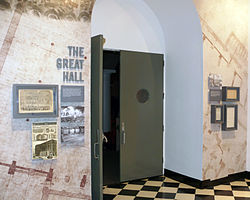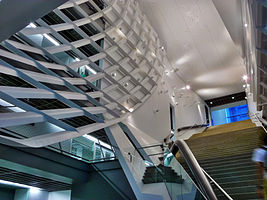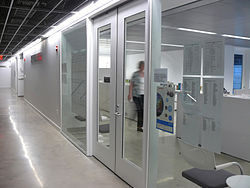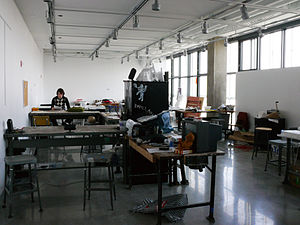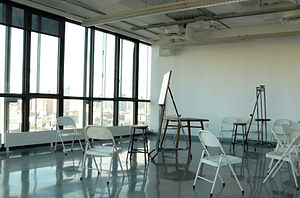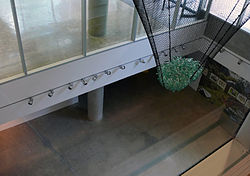- Cooper Union
-
Coordinates: 40°43′45″N 73°59′26″W / 40.72927°N 73.99058°W
The Cooper Union for the Advancement of Science and Art 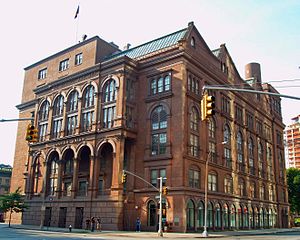
Cooper Union Foundation BuildingEstablished 1859 Type Private Endowment $598.2 million[1] President Jamshed Bharucha Academic staff 56 full time Students 918 Location New York, NY Campus Urban Colors Maroon and Gold Affiliations AICAD, ABET Website The Cooper Union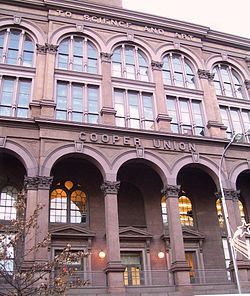 Close up of the Astor Place facade of the Foundation Building
Close up of the Astor Place facade of the Foundation BuildingLocation: Cooper Square, New York, NY Built: 1858 Architect: F.A. Peterson NRHP Reference#: 66000540 Significant dates Added to NRHP: October 15, 1966[2] Designated NHL: July 4, 1961[3] Designated NYCL: March 15, 1966 
The Cooper Union for the Advancement of Science and Art, commonly referred to simply as Cooper Union, is a privately funded college in the East Village neighborhood of Manhattan, New York City, United States, located at Cooper Square and Astor Place (Third Avenue and 6th–9th Streets). Founded in 1859, the school established a radical new model of American higher education: its mission reflects founder Peter Cooper's fundamental belief that an education "equal to the best"[4] should be accessible to those who qualify, independent of their race, religion, sex, wealth or social status. Dr. Jamshed Bharucha has succeeded George Campbell Jr. as the college’s twelfth President.
The college, which is divided into three schools – the Irwin S. Chanin School of Architecture, the School of Art and the Albert Nerken School of Engineering – offers internationally-accredited undergraduate and Master's degree programs exclusively in the fields of architecture, fine arts, and engineering as a member of the Accreditation Board for Engineering and Technology (ABET) and the Association of Independent Colleges of Art and Design (AICAD). Cooper is considered to be one of the most prestigious colleges in the United States, with all three of its member schools consistently ranked among the highest in the country.[5]
The Cooper Union is one of very few American institutions of higher learning to offer a full-tuition scholarship – valued at $140,000 as of 2010 – to every admitted student. As a result, The Cooper Union is one of the most selective colleges in the United States, with an acceptance rate generally below 10%, with both the art and architecture schools' acceptance rates often below 5%.[6] Cooper Union experienced a 20% increase in applications for the 2008–2009 academic year, further lowering the acceptance ratio.[7] The school also experienced a 70% increase in early decision applications for the 2009–2010 academic year.[8] As a result of its record low acceptance ratio for the fall-2010 incoming class, Cooper Union was named by Newsweek Magazine as the "#1 Most Desirable Small School"[9] and "#7 Most Desirable School"[10] overall.
Founding and early history
The Cooper Union was founded in 1859 by American industrialist Peter Cooper, who was a prolific inventor, successful entrepreneur, and one of America's richest businessmen at the time. Peter Cooper was a workingman's son who had less than a year of formal schooling, yet went on to become an industrialist and an inventor; Cooper designed and built America's first steam railroad engine. Cooper later made his fortune with a glue factory and iron foundry. After achieving wealth, he turned his entrepreneurial skills to successful ventures in real estate, insurance, railroads and telegraphy. He once ran for President under the Greenback Party, becoming the oldest person ever nominated for the presidential election.
In the late 1850s, when Cooper was a principal investor and first president of the New York, Newfoundland & London Telegraph Co., the firm undertook one of the 19th century's monumental technical enterprises—laying the first Transatlantic cable. Cooper also invented instant gelatin, with help from his wife, Sarah, who added fruit to what the world would come to know as Jell-O.
Peter Cooper's dream was to give talented young people the one privilege he lacked: a good education. He also wished to make possible the development of talent that otherwise would have gone undiscovered. To achieve these lofty goals, Cooper designated the majority of his wealth, primarily in the form of real estate holdings, to the creation and funding of The Cooper Union, a zero-tuition school with courses made freely available to any applicant. Discrimination based on race, religion, or sex was expressly prohibited.
Originally intended to be named simply "the Union," the Cooper Union began with adult education in night classes on the subjects of applied sciences and architectural drawing, as well as day classes primarily intended for women on the subjects of photography, telegraphy, typewriting and shorthand in what was called the College's Female School of Design. Initial board members included Horace Greeley and William Cullen Bryant, and early alumni included Thomas Edison and William Francis Deegan.
The Cooper Union's free classes—a landmark in American history and the prototype for what is now called continuing education—have evolved into three distinguished schools that make up The Cooper Union for the Advancement of Science and Art: the School of Art, the Irwin S. Chanin School of Architecture and the Albert Nerken School of Engineering. Peter Cooper's dream of providing an education "equal to the best" has since become reality. Since 1859, the Cooper Union has educated thousands of artists, architects and engineers, many of them leaders in their fields.[11]
Cooper Union's Foundation Building is an Italianate brownstone, and the first structure in New York City to feature rolled-iron I-beams for structural support; Peter Cooper himself invented and produced these beams.[12] The building was declared a National Historic Landmark in 1961,[3][13][14] and a New York City Landmark in 1965.[15]
The Great Hall
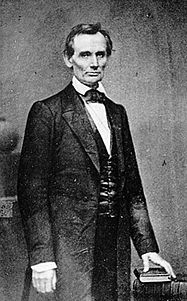 Photo of Abraham Lincoln taken February 27, 1860 in New York City by Mathew Brady, the day of his famous Cooper Union speech.
Photo of Abraham Lincoln taken February 27, 1860 in New York City by Mathew Brady, the day of his famous Cooper Union speech.
On February 27, 1860, the school's Great Hall, located in the basement level of the Foundation Building, became the site of a historic address by Abraham Lincoln.[16] Abraham Lincoln's dramatic speech opposed Stephen A. Douglas on the question of federal power to regulate and limit the spread of slavery to the federal territories and new States. Widely reported in the press and reprinted throughout the North in pamphlet form, the speech galvanized support for Lincoln and contributed to his gaining the Party's nomination for the Presidency. It is now referred to as the Cooper Union Address.[17]
Since then, the Great Hall has served as a platform for historic addresses by American Presidents Grant, Cleveland,[18] Taft,[19] Theodore Roosevelt,[20][21] Woodrow Wilson,[22][23][24] and Bill Clinton. Clinton spoke on May 12, 1993 about reducing the federal deficit and again on May 23, 2006, as the Keynote Speaker at The Cooper Union's 147th Commencement along with Anna Deavere Smith.[25] [26] He appeared a third time on April 23, 2007, along with Senator Edward Kennedy, Henry Kissinger, Norman Mailer, and others, at the memorial service for historian Arthur M. Schlesinger, Jr. Most recently, Barack Obama delivered an economic policy speech at Cooper Union's Great Hall on April 22, 2010.[27] [28]
In addition to addresses by political figures, the Great Hall hosts semi-annual meetings of the New York City Rent Control Board, as well as incidental organized protests and recreational events. It is the stage for Cooper Union's commencement ceremony as well as the annual student orientation meeting for incoming freshman students. Cooper Union's Great Hall was also the site of the school's inauguration, whose primary address was given by Mark Twain.
The Great Hall also continues to serve as an important metropolitan art space and has hosted lectures and performances by such key figures as Joseph Campbell, Steve Reich, Salman Rushdie, Ralph Nader, Hamza Yusuf, Richard Stallman, Rudolph Giuliani, Pema Chodron, Michael Bloomberg, Evo Morales, and Venezuelan president Hugo Chávez.
When not occupied by external or hosted events, the Great Hall is made accessible to students and faculty for large lectures and recreational activities, including the school's annual Culture Show. The Hall's audio/visual resources are operated by a student staff under faculty management, as part of Cooper Union's extensive work-study employment program, though some high-profile hosted events are operated by professional staff.
2008–2009 Renovation
In late 2008, the Great Hall was closed to students and outside events for the first major renovation of the hall since 1978.[29] This renovation and redecoration was overseen by Sam Anderson Architects, a firm created and led by Cooper Union School of Architecture alumni, while the Arup Acoustics company was responsible for analysis and renovation of the hall's acoustic profile, which included installation of modern sound diffusion paneling on the rear walls.
The audience seats, which had not been altered since a prior renovation in 1906, were replaced by modern seating designed to replicate the unique shape of the original furniture. In addition, the audio/visual and lighting systems of the Great Hall were updated to modern standards, including installation of ceiling-mounted digital projectors and intelligent lighting fixtures, to meet the increasing demands of hosted and student events. The hallway and lobby leading to the Great Hall were also redecorated during the renovation period, with additions featuring historical information and primary source documents relevant to the space.
Modern changes
The Cooper Union evolved over time into its current form, featuring schools in Architecture, Fine Art, and Engineering. At present, these three fields represent Cooper Union's degree programs (exclusively), though the schools of Mathematics and Humanities provide classes and faculty to all three programs. Despite changes in the names and kinds of degrees offered, the degree-granting programs are still completely tuition-free.
In September 1992, Cooper Union opened its Student Residence Hall, located across 3rd Avenue from the Foundation Building, as the school's first-ever on-campus housing resource.[30] This apartment-style dormitory provides living space for 178 students, or approximately one-fifth of the school's student population. In addition to resident assistants, the Residence Hall provides living spaces for incoming freshman students of all three schools. New first-year students are not required to live in the dormitory building, unlike housing policies of many other universities. Remaining space in the building, when available, is allocated to upper-class students based on individual housing needs.
Modern curricular changes include the consolidation of the School of Engineering's interdisciplinary engineering (IDE) major and BSE program, after faculty reviews of the two programs yielded votes of no confidence and concerns of limited support. In addition, the Engineering School curricula have been recently updated to allow for greater flexibility in scheduling and elective course selection.
41 Cooper Square
Main article: 41 Cooper SquareA new classroom, laboratory, and studio facility designed by Thom Mayne of Morphosis Architecture with associate architect Gruzen Samton. Construction was completed in Summer 2009, replacing the aging Hewitt Academic Building at 41 Cooper Square. In contrast to the Foundation Building, 41 Cooper Square is of modern, environmentally "green" design, housing nine above-ground floors and two basements. The structure features unconventional architectural features, including a full-height Grand Atrium, prevalent interior windows, a four-story linear central staircase, and upper-level skyways, which reflect the design intention of inspiring, socially interactive space for students and faculty. In addition, the building's design allows for up to 75% natural lighting, further reducing energy costs. Other "green" features in the design include servo-controlled external wall panels, which can be swiveled open or closed individually in order to regulate interior light and temperature, as well as motorized drapes on all exterior windows. In 2010, 41 Cooper Square became the first academic and laboratory structure in New York City to meet Platinum-level LEED standards for energy efficiency.[31] The building was funded largely by alumni donations, materialized in nameplates and other textual recognition throughout the building.[32]
Primarily designed to house The Cooper Union's School of Engineering and School of Art, the new building's first eight above-ground floors are populated by classrooms, small engineering laboratories, study lounges, art studio space, and faculty offices. The ninth, top floor is dedicated completely to School of Art studio and classroom space in addition to the art studio spaces located throughout the building. The lowest basement level consists almost completely of the school's large machine shops and design laboratories, as well as much of the HVAC and supply infrastructure. The building's first basement level houses primarily the Frederick P. Rose Auditorium, a 198-capacity lecture hall and event space designed as a smaller, more modern alternative to the Great Hall. In addition, the first basement's Menschel Conference Room provides a high-profile space for meetings and classes, and features a high-definition videoconferencing system linked to two other similar spaces in the upper floors of the building.
Connecting the first four floors of 41 Cooper Square is the linear Grand Staircase, which is used both for transportation and as a recreational space for students. Higher floors are connected by floating interior skyways, in addition to two standard corner staircases and three passenger elevators. At the peak of the Grand Staircase is the Ware & Drucker Student Lounge, which houses a small cafeteria service for students as well as a relaxed, naturally lit study location.
Financial support
A substantial portion of the annual budget, which supports the full-tuition scholarships in addition to the school's costs, is generated through donations from alumni in both the public and the private sector. In addition, real estate has become a very important asset to the College and has drastically increased its endowment to over $600 million.[33] The land under the Chrysler Building is owned by the endowment,[34] and as of 2009, Cooper Union received $7 million per year from this parcel. Further, under a very unusual arrangement, New York City real-estate taxes assessed against the Chrysler lease, held by Tishman Speyer, are paid to Cooper Union, not the city. This arrangement would be voided if Cooper Union sold the real estate. In 2006, Tishman Speyer signed a deal with the school to pay rent that will escalate to $32.5 million in 2018, $41 million in 2028 and $55 million in 2038. Cooper Union investment committee member John Michaelson acknowledged to the Wall Street Journal that Tishman Speyer "would not have signed a generous agreement like that had it been approached in 2009.".[35]
Financial crisis
Around October 29, 2011, rumors leaked out that the school was in serious financial trouble, and on October 31st, a series of open forums were held with students, faculty, and alumni to address the crisis.[36] Speaking on social networking websites, current and past students voiced opposition to the plan. The president of the school, Jamshed Bharucha, indicated that depletion of the school's endowment required additional sources of funding, such as a possible tuition levy and more pointed solicitation of alumni donations and research grants, were being considered to offset recent financial practices such as liquidating assets and spending heavily on a controversial new academic building.
The Albert Nerken School of Engineering
The Cooper Union School of Engineering's enrollment includes about 550 students, and is the largest of the three schools by a significant margin. It is one of the most prestigious and selective engineering schools in the United States, consistently ranked within the top four undergraduate engineering programs among non-doctorate-awarding schools nationwide.[37] The school offers ABET accredited Bachelor of Engineering (B.E.) programs in Chemical, Civil, Electrical, and Mechanical Engineering. In addition, Cooper Union offers an Interdisciplinary Engineering program, leading to a Middle States accredited B.S.E. degree.
All School of Engineering departments maintain a focus on project-based learning and opportunities for extension through undergraduate research, in addition to training students in the science and mathematics fundamental to engineering practice.[38] Because Cooper Union does not offer a Doctoral program, all of the institution's research is carried out by undergraduate and Master's students in partnership with faculty and staff.
The School of Engineering's B.E. degrees are designed to prepare students for either direct industry employment or continued, graduate-level engineering education in their particular field. Students in the B.E. program may choose to proceed into a 5th-year Master of Engineering (M.E.) program, or even (in some cases) complete the requirements for both the B.E. and M.E. degrees within four years. In contrast, the interdisciplinary B.S.E. program is intended for those students interested in further education in the fields of medicine, business, and law (specifically patent law), and provides a curriculum with broader focus and emphasis on the application of engineering and science skills to other, related fields.
In addition to core and elective coursework, engineering students are required to take part in the "Cooper's Own No Nonsense Engineering Communication Training" (CONNECT) program, which provides workshops and lectures in technical writing, oral presentation, public relations, and other communication-related topics relevant to engineering practice in industry. Facilitators and teachers in the CONNECT program generally have backgrounds in theatre, business writing, journalism, or communication, rather than engineering and science, and therefore offer a broader gamut of communication-related skills than Cooper's core faculty.[39] The program was introduced in 1994 by Professor Richard Stock, Ph.D of Cooper Union's Chemical Engineering department, and Dr. John Osborn, an instructor of drama at New York University, in response to practicing engineers' need for professional presentation skills as well as industry demands for employees capable of accurately and effectively communicating the details of their work to management and third parties.[40]
Simon Ben Avi is currently the Acting Dean of the Albert Nerken School of Engineering, succeeding Eleanor Baum, the former Dean. She was the first woman to be named as dean of an engineering college or university and is an Electrical Engineer. Dean Baum was recently named to the National Women's Hall of Fame[41]
Curriculum
All bachelor's programs offered by the School of Engineering require a minimum of 135 credits for graduation, including completion of a core program of general engineering and science classes as well as a minimum of 24 credits in the Faculty of Humanities and Social Sciences.[42] Each department maintains additional degree requirements, including both core and elective courses within the relevant field.
The 55-credit core program, which is required of all engineering students (regardless of major), consists of 17 specific courses in the fields of Mathematics, Physical Science, and Humanities and Social Sciences, as well as two project-oriented courses in Engineering Design. The academic curriculum is designed such that all students are capable of completing this core curriculum by the end of their Sophomore year, though many students postpone required core courses until the third or fourth year in favor of additional electives.[43]
In addition to the general curricular demands of each department, students in the Chemical, Civil, Mechanical, or Interdisciplinary Engineering programs may opt to obtain an academic minor in a specific discipline of their engineering field. In order to obtain a minor, a student must enroll in at least four additional 3-credit courses relevant to the area of specialization.[44] Minors from the Humanities and Mathematics departments are available to all engineering students.
Master's Program
The Master of Engineering program offers an opportunity for Cooper Union undergraduate students to obtain a Master's degree in one of the four named engineering disciplines while conducting research at the school. Students in the Master's Program are teamed with a full-time professor in their department for the research and design project. The requirements for the Master's Degree are a 30-credit course of study, including a 12-credit major and a 12-credit minor. At least 6 credits of Master's Thesis study are also required. Candidates for this degree are also required to conduct an oral defense of their thesis which is organized by the department faculty. The Cooper Union hosts, on average, 20 Master's degree students per year.[45][46][47] As with the undergraduate program, Master's students pay no tuition costs.
Departments and majors
Unlike many engineering schools, there is no option for "general studies" at the Cooper Union, even in the first year. All applicants must declare their major on application, enrolling themselves in a particular department (or the interdisciplinary B.S.E. program) before they arrive.[48] Once at Cooper, switching majors within the Engineering school is permitted, but a cumulative GPA of 3.0 and faculty approval are required. Most department-specific courses do not begin until the latter half of the second year, and therefore switching majors before that point is very feasible from a curricular standpoint. However, given the intense and competitive nature of the first two years, maintaining the academic requirements for eligibility can be extremely difficult.
Chemical engineering
The chemical engineering curriculum and program structure is designed to provide students with thorough knowledge of energy and material balances, thermodynamics, and the physical and reactive characteristics of chemical structures, in order to facilitate creative design and analysis of chemical and nuclear systems. Major focus is given to understanding and quantification of the relevant safety, cost, and environmental impact of such systems. The Chemical Engineering curriculum includes a total of 53 credits in specific required courses (in addition to the 55-credit engineering core curriculum).[38]
In addition to the Chemical Engineering major, students have the option to obtain one of four minors through the department: biomedical engineering, environmental engineering, applied chemical technology, or energy engineering.
Civil engineering
Civil engineering is the oldest and smallest degree-granting engineering program at Cooper Union; roughly 25 students are admitted into the undergraduate program each year.[49] In addition to the core curriculum, Civil Engineering students are required to take an additional 47 credits in specific CE courses. The Civil Engineering program focuses heavily on the topics of mechanics, materials science, and computer-aided design and analysis. These subjects are the foundation for civil engineering applications including structural/infrastructural, geotechnical, environmental, and transportation design. Students are also educated in the processes and analysis methods relevant to the development of new materials and structural systems.[38]
Academic minors available in the Civil Engineering department include "Structural and Geotechnical Engineering" and "Water Resources and Environmental Engineering".[50]
Electrical engineering
Cooper Union's electrical engineering program, which enrolls about 50 new students per academic year, is consistently ranked among the top undergraduate programs in its field.[51] Unlike other engineering departments at The Cooper Union, the Electrical Engineering program does not offer students the opportunity to pursue an academic minor, instead offering three curricular "tracks" which students may adopt. All students in the program are required to choose a specialization, and each has unique graduation requirements.
The Computer Engineering track is designed to develop skills in computer architecture, systems programming, data communication networks, and artificial intelligence. The Signals track focuses on DSP algorithms and their implementation in hardware and software, as well as electronic imaging/sensing technologies and communication systems. Finally, the Electronic Systems and Materials specialization bridges Electrical Engineering and Materials Science, including advanced integrated circuit design and the production of semiconductors and optical materials. All tracks also include a general electrical engineering curriculum, covering circuits, digital logic, control systems, signal processing, and computer programming.[52]
Mechanical engineering
In addition to being the largest of Cooper Union's engineering departments, the Mechanical Engineering program is also the broadest and most versatile; students study varied topics including thermodynamics, control engineering, mechanics, materials science, systems, and instrumentation, and may choose to pursue individually crafted specializations through elective coursework.[53] Students are encouraged to customize their educational curriculum by replacing (with prior approval) core engineering curriculum courses with additional electives, whether within the Mechanical Engineering department or in a different field. Common specializations include Aerospace, Biomechanical, and Robotics Engineering.[54]
Other departments
The School of Engineering is also home to three other departments; Chemistry, Mathematics, and Physics. In addition to providing required and elective courses in their respective subjects to students in all majors, the faculty of these departments provide engineering students with research and independent study opportunities. In addition, faculty from the Department of Chemistry direct master's degree students in fundamental and applied research projects in partnership with the Department of Chemical Engineering. [55] The Chemistry and Mathematics departments are two of the original departments established in 1859 at the founding of the Cooper Union. [56]
The School of Art
Consisting of roughly 200 students and 70 faculty members,[57] the Cooper Union School of Art draws on the creative energy of the East Village to produce some of the most distinguished artists in the world today. The school offers a 4-year program leading to a Bachelor of Fine Arts (B.F.A) degree, which can be extended to 5 years with faculty approval. In addition, students may instead opt to receive a Certificate of Fine Arts degree, which can be completed in two years of study.[58] As a member school of AICAD, School of Art students may participate in exchange programs with the other colleges in the Association, including California Institute of the Arts and Otis College of Art and Design.[59]
The Cooper Union Art program is often referred to as "generalist" or "versatile" when compared to other Fine Arts colleges; incoming students do not choose an academic major within the Fine Arts field, but instead are permitted and encouraged to select courses from any of the School of Art's departments.[60] This approach allows for a personalized curriculum which addresses each student's particular interests, regardless of variation or eclecticism. In addition, the program and curriculum place heavy emphasis on each student's creative and imaginative abilities, rather than technical precision in a specific medium, to develop the social awareness and critical analysis skills relevant to art in the contemporary world.[61]
Notable alumni of the Cooper Union School of Art include Seymour Chwast, Milton Glaser, Herb Lubalin, J. Abbott Miller, Lou Dorfsman, Ellen Lupton, Paul Carlos, Joel Peter Witkin, Tom Kluepfel, Stephen Doyle, Alexander Isley, Eva Hesse, Alex Katz and Hans Haacke.
Curator Saskia Bos was appointed Dean of the School of Art in 2005.
Admissions
The Cooper Union boasts the lowest acceptance rate of any fine arts college in the United States, and is considered to be one of the most desirable programs in its field, with over 70% of accepted students choosing to attend.[62][63] The School of Art chooses to accept, on average, 60 first-year and 2 transfer students each academic year. An early decision application is available; approximately 60% of accepted students are early decision applicants.[64]
In addition to standard SAT and transcript requirements, the School of Art requires all applicants to complete a rigorous "hometest," which spans a 4-week period and plays a primary role in the admissions decision process. This conceptually-focused assessment consists of 6 prompts addressed by applicants using visual pieces in any medium, as well as 10 short-answer writing prompts.[65] In addition, first-year students are required to submit a portfolio consisting of 10–20 recent works which demonstrate the artist's creative and technical ability. The School of Art encourages all applicants to attend an open house prior to portfolio submission, wherein faculty members are available to offer suggestions and advice regarding portfolio compilation.[66]
Curriculum
The School of Art's four-year B.F.A. curriculum consists primarily of elective studio and academic courses, which can be chosen by students to personalize their education and experience. In addition, a total of 39 credits in specific courses are required of all students. This core curriculum includes literature, social sciences, art history, and writing courses, in addition to "foundation" studio courses in color, drawing, and design.[67] Foundation-level art courses are completed by all students within their first year at The Cooper Union, leaving the remaining three years completely open for elective studio courses which can be chosen from departments including sculpture, painting, video, photography, traditional and computer animation, graphic design, typography, printmaking, and new media.[58] A total of 55 credits in elective studio courses are required for graduation, in addition to 12 credits of other electives.
Students in the Certificate of Fine Arts program must complete at least 27 credits in elective studio courses, in addition to a 24-credit subset of the core curriculum. This program is generally limited to an extremely small number of "special case" students for whom the B.F.A. program is deemed inappropriate or impossible. C.F.A. students may apply for transfer to the B.F.A. program after completing 42 total credits in the School of Art.[58]
All graduating students are required to complete a final exhibition of their work, which can be installed in any of The Cooper Union's gallery spaces and remains publicly accessible for two to four days.[68]
Facilities
The Cooper Union School of Art's studio, workspace, gallery, and classroom spaces are located throughout the Foundation Building and 41 Cooper Square, and provide comprehensive resources for students working in any Fine Arts department.
Student workspaces
Sophomore, Junior, and Senior Art students may apply for personal studio space in either the Foundation Building or 41 Cooper Square, which can be used for project storage as well as production space for media not requiring a specialized facility.[69] Student studio spaces are generally divided areas or cubicles of larger rooms, with the central areas open for large-scale work. All resident students must agree to a "studio use contract" upon application, which designates liability and responsibility for damages and misuse of space.
All student workspaces feature sinks, electrical outlets, and space for hanging or mounting artwork. Immediately outside each studio room is a partitioned storage and disposal system for hazardous and flammable media and materials. Personal studio rooms in 41 Cooper Square are naturally lit and feature high ceilings and advanced multimedia capabilities; as a result, these spaces are generally reserved by Junior and Senior students taking courses in the building, who have priority in the selection process.
Occasionally, first-year Art students living a significant distance from the school's campus are granted shared studio spaces for storage.[58] Because most freshman students choose to live in the Cooper Union Residence Hall immediately across the street, this exception is rarely justified.
Studios, shops, and labs
Because each discipline of fine art requires specific equipment and conditions, the School of Art maintains 20 workrooms dedicated to the production of specific media, in both the Foundation Building and 41 Cooper Square.[58]
- The School of Art's two Computer Studios are state-of-the-art computing facilities in 41 Cooper Square which provide classroom and lab space for students and faculty to produce and present digital work. They feature 40 Xeon-based Mac Pro workstations for student use, along with professional grade scanning, imaging, and printing devices for archival, large-format printing, film production, video editing, and audio production. These studios are often used as classrooms for Graphic Design and Computer Animation courses. Additional production equipment including audio recording interfaces, digital cameras, and microphones are available for student rental through the interdisciplinary audio/visual department.[70]
- Several painting and drawing studios and classrooms are available within both buildings on campus, providing easels, palette stands, sawhorse tables, and mounting hardware for props and reference images. In addition, all painting studios include sinks and storage racks for projects and equipment. The Painting Office in the Foundation building provides additional materials and equipment for rent and sale. The Foundation Building painting studios and classrooms feature skylights, providing a naturally lit workspace environment, while 41 Cooper Square's studios provide a similar atmosphere with full-size windows on all external walls.
- The photography department maintains one communal black-and-white and eight individual color darkrooms, containing enlargers and print processing equipment in addition to the chemical and paper media used for film photography. Each photography studio is staffed by student assistants who operate and maintain the equipment, in addition to providing rental services for film and digital SLR cameras. The Foundation Building photography workspace includes two- and three-dimensional sets, complete with photographic lighting resources, for film or digital imaging.
- Printmaking resources and equipment are stored in a large, well-ventilated shop space on the 3rd floor of the Foundation Building. In addition to computer workspaces for digital design and production, the facility features lithography presses, silkscreen vacuum tables, and etching equipment, as well as paper mills and stones for paper-making and manual lithography.
- Film and Video studios are located in the Foundation building and provide resources, equipment, and work space for film and digital video production, from pre-production to publication. Microphones, lighting kits, and tripods are freely available for student use and rental, in addition to Super8, 16 mm, MiniDV, 24p, and HDV camcorders. Eight video-editing computer workstations are also available, and feature Final Cut Studio and Adobe Creative Suite editing software in addition to audio and video capture and trans-coding hardware. Scanners, rotoscopes, editing workstations, and other equipment used for the production of traditional, computer, and stop-motion animation are located in a second computer lab adjacent to the video and film studio.
Galleries
Located in both public spaces and specialized rooms, Cooper Union's galleries provide space for installations and showcases by students, faculty, and guest artists.[68] Popular gallery locations include the Great Hall lobby in the Foundation Building and newly-opened 41 Cooper Gallery in 41 Cooper Square, which provides a three-story high space for large, three-dimensional exhibitions and works visible from both the building lobby and 7th street through large plate-glass windows.
In addition, numerous smaller exhibition spaces exist throughout both buildings on campus, providing space for student projects and individual artwork to be displayed. Larger spaces on the upper floors of the Foundation Building are used primarily for interdisciplinary exhibitions with the School of Architecture. For presentations of video and digital media, the Great Hall and 41 Cooper Square's Rose Auditorium are used. Exhibition resources including frames, stands, projectors, and mounting hardware are provided to students and faculty by the school's Buildings and Grounds department.[58]
Irwin S. Chanin School of Architecture
The Irwin S. Chanin School of Architecture at The Cooper Union offers a five-year program leading to a Bachelor of Architecture degree. The school ranks among the top five architecture programs in the United States.[71] The philosophical foundation of the school is committed to the complex symbiotic relationships of education, research, theory, and practice.
The five-year Design sequence is structured to integrate the elements of architecture: investigation of program, construction, structure, and form/space. The Design sequence is intended to generate effective, forceful and spirited architecture.
With over 8,000 square feet (740 m2) of studio space, each student has his or her own drafting and work area. The studio functions as a classroom in which instruction occurs, as a laboratory in which projects are conceived and developed, and as a base of operations. Classroom facilities include a lecture hall, seminar room, and ample presentation space. There is also a computer lab available for student use on the seventh floor.
The faculty includes many influential practicing architects and theorists (Diana Agrest, Diane Lewis, and Lebbeus Woods). Well-known graduates of the school include Shigeru Ban, Daniel Libeskind, Karen Bausman, Elizabeth Diller and Ricardo Scofidio. The current dean is Anthony Vidler.
M. Arch II
The Cooper Union introduced the new, M.Arch II program for the 2008–2009 academic year.[72] The program will be limited to a total of eight students, and offer three concentrations: Theory, History, and Criticism of Architecture; Urban Studies; and Technologies.[73]
Faculty of Humanities and Social Sciences
The Faculty of Humanities and Social Sciences provides the academic thread that binds the three schools into a tightly integrated whole. The Cooper Union is committed to the principle that an education in the liberal arts provides the ethical, social and humanistic framework crucial to personal development and professional excellence; thus, all students in the first two years take a core curriculum of required courses in the humanities and social sciences. These courses are not segregated by member school or academic major, and provide a formal opportunity for students in each of the three Schools to interact in an interdisciplinary environment. Students in the School of Art take an additional three-semester sequence in art history. During the third and fourth years, students have considerable latitude to explore the humanities and social sciences through elective courses. The Center for Writing works with all students throughout their time at The Cooper Union, providing both tutoring for Humanities courses and assistance with other writing-related tasks (such as technical documentation of research projects and the production of Résumés.)
Athletics
In recent years, Cooper Union, lead by Steve Baker, the school's Associate Dean and Health and Recreations Director, has developed a division III NCAA athletic program[74] which fields teams in eight sports. Because CU does not have athletic facilities, those at nearby schools are used instead.[75]
Notable alumni
With fewer than 1,000 students, Alumni of the Cooper Union win a vastly disproportionate share of the nation's most prestigious awards. Recent awards include one Nobel Prize, ten Rome Prizes, 18 Guggenheim fellowships, three MacArthur fellowships, nine Chrysler Design awards, and three American Institute of Architects Thomas Jefferson Awards for Public Architecture. The school also boasts more than 23 Fulbright scholars since 2001, and ten National Science Foundation Graduate Research Fellowships since 2004.[76]
The Cooper Union Alumni Council presents three awards annually to notable alumni: the Augustus Saint Gaudens Award for professional achievement in art, the Gano Dunn Award for professional achievement in engineering, industry, or finance, and the John Q. Hejduk Award for architecture alumni who have made an outstanding contribution to the theory, teaching and/or practice of architecture. Other awards presented by the Alumni Council are the Alumnus of the Year and the Young Alumnus of the Year Awards.
Notable alumni of the Cooper Union include:
- John Alcorn, illustrator
- Stan Allen, Dean of the School of Architecture, Princeton University
- Daniel Arsham, artist, with alumnus Alex Mustonen established Snarkitecture
- Alex Bag, video artist
- Shigeru Ban, pioneer of "Paper Architecture"
- Donald Baechler, painter
- Karen Bausman, Rome Prize recipient, the only American woman architect to hold both the Eliot Noyes (Harvard) and Eero Saarinen (Yale) chairs
- Billy Bitzer, cinematographer
- Dik Browne, cartoonist and creator of Hagar the Horrible
- Albert Carnesale, former chancellor of UCLA
- Martin Charnin, Tony Award-winning lyricist, writer, and theatre director
- Remy Charlip, choreographer, writer, and illustrator
- John Walter Christie, engineer and inventor
- Guy Coheleach, wildlife artist
- Will Cotton, painter
- Miriam Cooper, silent film actress who appeared in Birth of a Nation
- William Francis Deegan, architect and political leader, namesake of the Major Deegan Expressway
- Roy DeCarava, photographer
- Elizabeth Diller, with Ricardo Scofidio, the first architects to win a MacArthur Prize
- Michael Doret, graphic designer, font designer, lettering artist
- Lou Dorfsman
- Thomas Edison, inventor[77]
- Jeffrey Epstein, investor
- Mitch Epstein, photographer
- Thom Fitzgerald, filmmaker
- Audrey Flack, pioneer of photorealism
- Max Fleischer, animator
- Robert Florczak, artist, illustrator, author, composer
- Laura Ford, sculptor
- Janet Gardner, filmmaker
- Milton Glaser, graphic designer, founder New York Magazine, creator of the I Love New York logo
- Sagi Haviv, partner, Chermayeff & Geismar; designer of the Library of Congress and Armani Exchange logos
- John Hejduk, one of New York Five a group of five New York City architects
- Eva Hesse
- Chuck Hoberman, winner of the Chrysler Design Award for Innovation and Design.
- Kim Holleman, artist
- Russell Hulse, a 1993 winner of the Nobel Prize in Physics.[78]
- Alexander Isley, graphic designer
- Crockett Johnson, author of Harold and the Purple Crayon
- Bob Kane (1915–1998), comic book artist and writer, creator of Batman [79]
- Michael J. King,[2] professor of Petroleum Engineering, Texas A&M
- William King
- R.B. Kitaj, painter
- Lee Krasner, painter
- Daniel Libeskind, architect for the reconstruction of the World Trade Center
- Herb Lubalin
- Ellen Lupton, graphic designer, writer, curator and educator
- Noah Lyon, artist
- Jay Maisel, photographer
- Fred Marcellino, illustrator
- Sylvia Plimack Mangold
- Joseph Margulies, artist
- Mike Mills, filmmaker
- Matthew Monahan, sculptor
- Michel Mossessian, architect
- Wangechi Mutu, artist
- Albert Nerken, chemical engineer, industrialist and philanthropist [80]
- Victor Papanek, early proponent of ecologically and socially responsible design
- Bruce Pasternack, President and CEO of the Special Olympics
- Charles E. Pont, painter, illustrator, printmaker, graphic designer
- Augustus Saint-Gaudens, Beaux-Arts sculptor
- Erik Sanko, marionette-maker and leader of the rock band Skeleton Key
- Alfred Sarant Soviet spy, and later became head of Zelenograd, the Soviet "silicon valley"
- Richard Sarles, CEO and General Manager of Washington Metropolitan Area Transit Authority[81][82]
- Domitilla Sartogo, owner, founding partner and executive director of DRAGO Media Kompany
- Augusta Savage, sculptor
- Arnold Alfred Schmidt, painter
- Ricardo Scofidio, with Elizabeth Diller, the first architects to win a MacArthur Prize
- Samuel R. Scottron, inventor, grandfather of entertainer Lena Horne
- Georgette Seabrooke, muralist, artist, art therapist and educator
- George Segal, pop art sculptor
- Redmond Simonsen, graphic artist and game designer at the wargame company Simulations Publications, Inc.
- Dr. Michael B. Sisti, neurosurgeon at Columbia University
- Zak Smith, artist
- Charles B.J. Snyder (1860–1945), chief architect and Superintendent of School Buildings, New York City Board of Education, 1891–1923
- Edward Sorel, graphic designer
- Thaddeus Strassberger, opera director
- Philip Taaffe, painter
- TRUE, artist
- Hy Turkin, sportswriter and editor of the first baseball encyclopedia
- Richard Velazquez, Honda and Porsche designer
- Allyson Vieira, artist
- Edward J. Wasp, engineer and pioneer of slurry pipelines
- Adolph Alexander Weinman, sculptor
- Tom Wesselmann, painter
- Joel-Peter Witkin, fine art photographer
- Dan Witz, painter, street artist
- Tobi Wong, designer, artist
- Harry Zaverdas, ITC Herb Lubalin Award 1985, graphic designer, photographer
In popular culture
- Ugly Betty was shot in 41 Cooper Square on September 23, 2009.[83]
- The Cooper Union acts as a symbol of Progressivism in the Pulitzer Prize-winning novel His Family by Ernest Poole.
- In Susan Skoog's coming-of-age independent film Whatever, precocious suburban teen Anna Stockard (Liza Weil) harbors dreams of moving to the city to study art at the Cooper Union in the early 80s.[84]
- The Cooper Union is mentioned in a spoken word performance of Bowery Blues read by Jack Kerouac with piano accompaniment by Steve Allen.
- In the German cult film Killer Condom, the laboratory in which the villain manufactures penis-eating condom monsters is located in the basement of the school. One of the final scenes was shot outside the Foundation building entrance.
- The Cooper Union and their student dorms were featured as background in The Interpreter starring Nicole Kidman and Sean Penn. The school is also frequently seen in episodes of Law and Order: Special Victims Unit, as well as Law and Order: Criminal Intent.
- The Cooper Union makes an appearance in the Norwegian children's television program Lillys Butikk as the school of the lead character's son John, in his video-letter home.
- The school appeared in an episode of The Office, and was mentioned in an episode of Will & Grace in which Grace has an intern from the Cooper Union.
- The name of the Cooper Union appears briefly on signs held by suffragettes in the Schoolhouse Rock video Sufferin' Until Suffrage.[85]
- A baby grand piano which appeared on a sandbar in Biscayne Bay, Florida in January 2011 turned out to be part of a plan for a student who hoped to get into Cooper Union.[86]
- A 2011 commercial for IBM was filmed inside 41 Cooper Square.
See also
References
- Notes
- ^ "College and University Endowments Over $250-Million, 2007". Chronicle of Higher Education: p. 28. 2008-08-29.
- ^ "National Register Information System". National Register of Historic Places. National Park Service. 2007-01-23. http://nrhp.focus.nps.gov/natreg/docs/All_Data.html.
- ^ a b "Cooper Union". National Historic Landmark summary listing. National Park Service. 2007-09-11. http://tps.cr.nps.gov/nhl/detail.cfm?ResourceId=390&ResourceType=Building.
- ^ See original Cooper Union charter, trust deed, and by-laws: http://books.google.com/books?id=ek0XAAAAYAAJ&pg=PA21&lpg=PA21&dq=%22equal+to+the+best%22++%22peter+cooper%22&source=bl&ots=Bw85N-upDU&sig=369TkWve3K0G2MFey3xVQL5Uz_Y&hl=en&ei=A9_DTr2yGOfa0QGLhrmiBg&sa=X&oi=book_result&ct=result&resnum=6&ved=0CFIQ6AEwBQ#v=onepage&q=%22equal%20to%20the%20best%22&f=false
- ^ "Best Colleges | Find the Best College for You | US News Education". Colleges.usnews.rankingsandreviews.com. 2011-01-31. http://colleges.usnews.rankingsandreviews.com/usnews/edu/college/rankings/brief/t1ccbach_n_brief.php. Retrieved 2011-03-16.
- ^ America's Best Colleges 2008: LOWEST ACCEPTANCE RATES
- ^ The Cooper Union Awards $33 million in Full Tuition Scholarships
- ^ Foderaro, Lisa W. (February 9, 2009). "Applications Surge at Cooper Union". The New York Times. http://www.nytimes.com/2009/02/09/education/09cooper.html. Retrieved April 1, 2010.
- ^ September 12, 2010 (2010-09-12). "Cooper Union - Newsweek - Education". Education.newsweek.com. http://education.newsweek.com/2010/09/12/the-25-most-desirable-small-schools/cooper-union.html. Retrieved 2011-03-16.
- ^ September 12, 2010 (2010-09-12). "Cooper Union - Newsweek - Education". Education.newsweek.com. http://education.newsweek.com/2010/09/12/the-25-most-desirable-schools/cooper-union.html. Retrieved 2011-03-16.
- ^ The Cooper Union: History. Retrieved November 14, 2006
- ^ One College Sidesteps the Crisis, Wall Street Journal, Money & Investing, June 30, 2009, p. c1
- ^ "National Register of Historic Places Inventory". National Park Service. 1975-08-08. http://pdfhost.focus.nps.gov/docs/NHLS/Text/66000540.pdf.
- ^ "National Register of Historic Places Inventory". National Park Service. 1975-08-08. http://pdfhost.focus.nps.gov/docs/NHLS/Photos/66000540.pdf.
- ^ New York City Landmarks Preservation Commission. Guide to New York City Landmarks (4th ed.) New York:Wiley, 2009. ISBN 978-0-470-28963-1, p.65
- ^ Harold Holzer "The Speech that Made the Man," American Heritage, Winter 2010.
- ^ Holzer, Harold. "Still a Great Hall After All" American Heritage, April/May 2004.
- ^ "PRAISED BY THE GERMANS; MR. CLEVELAND GREETED WITH WILD APPLAUSE. HIS FRIENDS FROM "FATHERLAND" THRONG COOPER UNION. A GREAT OUTPOURING OF GERMAN-AMERICANS TO SEE AND HEAR THE DEMOCRATIC CANDIDATE –- THE EX-PRESIDENT'S HAPPY SPEECH ADDS TO HIS POPULARITY – CARL SCHURZ POINTS OUT THE DANGERS WHICH WOULD FOLLOW REPUBLICAN SUCCESS – AN APPEAL TO WHICH ALL GERMAN CITIZENS WILL RESPOND – OVERFLOW MEETINGS FOR THOUSANDS WHO COULD NOT GET INTO THE HALL." (PDF). New York Times. 1892-10-28. p. 1. http://query.nytimes.com/mem/archive-free/pdf?res=9906E6DE1338E233A2575BC2A9669D94639ED7CF. Retrieved 2010-06-24. "It might be claiming too much to say that the Democratic Party as such gives a sufficient guarantee for the improvement of political methods or avoidance of these wrongdoings."
- ^ "TAFT DEFENDS BOTH CAPITAL AND LABOR; Tells Cooper Union Audience He's for Union Shops and Mutual Conciliation. NOT HAILED AS PRESIDENT Cordial Greeting at First Grows Warmer After He Answers Volley of Questions." (PDF). New York Times. January 11, 1908. p. 1. http://query.nytimes.com/mem/archive-free/pdf?res=9804E1DB173EE233A25752C1A9679C946997D6CF. Retrieved 2010-06-24. "Give the Government the ownership of mines and railroads and like enterprises, and I tremble to think of the danger to the Republic."
- ^ "ROOSEVELT BITTERLY ATTACKS WILSON; Tells Cooper Union Audience the President Cares Nothing for the Nation's Soul." (PDF). New York Times. 1916-11-04. p. 4. http://query.nytimes.com/mem/archive-free/pdf?res=9E04E0DB1430E733A05757C0A9679D946796D6CF. Retrieved 2010-06-21. "I have not said one thing of him which I did not deem it necessary to say because of the vital interests of this Republic."
- ^ Roosevelt, Theodore (1917). Americanism and preparedness: Speeches of Theodore Roosevelt, July to November, 1916. New York: The Mail and express job print. pp. 134–145. http://books.google.com/books?id=yro_AAAAYAAJ&dq=%22cooper%20union%22%20%20%22theodore%20roosevelt%22&pg=PA145#v=onepage&q=%22cooper%20union%22%20&f=false. Retrieved 2010-06-21. "There can be no greater misfortune for a free nation than to find itself under incapable leadership when confronted by a great crisis."
- ^ Wilson, Woodrow (1913). The New Freedom: A call for the emancipation of the generous energies of a people. New York: Doubleday, Page & Company. pp. 98–99. http://books.google.com/books?id=xgwAAAAAYAAJ&dq=%22cooper%20union%22%20%20%22woodrow%20wilson%22&pg=PA99#v=onepage&q=cooper%20union&f=false. Retrieved 2010-06-21. "One of the valuable lessons of my life was due to the fact that at a comparatively early age in my experience as a public speaker I had the privilege of speaking in Cooper Union in New York."
- ^ "WILSON SAYS ELASTICITY SAVES THE CONSTITUTION; Made to Help, Not to Hinder, Asserts Princeton's President." (PDF). New York Times. 1904-11-20. p. 5. http://query.nytimes.com/mem/archive-free/pdf?res=9C07EED61E3BE631A25753C2A9679D946597D6CF. Retrieved 2010-06-21. "The Constitution was not made to fit us like a straitjacket."
- ^ "THREE BIG MEETINGS HERE; President Says Some in Campaign Have Tried to Discredit Government. EFFORT TO DIVIDE CLASSES Tells 15,000 in Madison Square Garden the Country Stands at a Serious Turning Point. PREDICTS HIS RE-ELECTION. President and Mrs. Wilson Scale Fire Escape to Get Into Garden." (PDF). New York Times. 1916-11-03. p. 1. http://query.nytimes.com/mem/archive-free/pdf?res=9A00E5D8143BE633A25750C0A9679D946796D6CF. Retrieved 2010-06-21. "COOPER UNION PACKED; Enthusiastic Throng Cheers the President for Five Minutes"
- ^ "Remarks at Cooper Union for the Advancement of Science and Art in New York City" (PDF). Weekly Compilation of Presidential Documents Volume 29, Number 19. (GPO). 1993-05-17. pp. 835–841. http://www.gpo.gov/fdsys/pkg/WCPD-1993-05-17/pdf/WCPD-1993-05-17-Pg835.pdf. Retrieved 2010-06-21.
- ^ "FORMER PRESIDENT BILL CLINTON TO DELIVER KEYNOTE ADDRESS AT THE 147th COMMENCEMENT OF THE COOPER UNION FOR THE ADVANCEMENT OF SCIENCE AND ART; ANNA DEAVERE SMITH IS COMMENCEMENT SPEAKER". Cooper Union. http://www.cooper.edu/news/press_relarchive.html#commencement. Retrieved 2010-06-21.
- ^ Obama to Wall St.: ‘Join Us, Instead of Fighting Us’ The New York Times April 22, 2010
- ^ "Remarks at the Cooper Union for the Advancement of Science and Art in New York City" (PDF). Daily Compilation of Presidential Documents;Administration of Barack H. Obama, 2010. (GPO). 2010-04-22. pp. 1–6. DCPD Number: DCPD201000290. http://www.gpoaccess.gov/presdocs/2010/DCPD-201000290.pdf. Retrieved 2010-06-21.
- ^ http://atcooper.cooper.edu/pdfs/ACUs09_briefs.pdf
- ^ "Residence Hall". Cooper.edu. 2007-06-25. http://www.cooper.edu/admin/residence/index.html. Retrieved 2011-03-16.
- ^ "The Cooper Union Builds | Naming Opportunities". Cooper.edu. http://www.cooper.edu/cubuilds/green.html. Retrieved 2011-03-16.
- ^ "The Cooper Union Builds | Donors". Cooper.edu. http://www.cooper.edu/cubuilds/donors.html. Retrieved 2011-03-16.
- ^ Smart Land Deals as a Cornerstone for Free Tuition
- ^ Gregor, Alison (February 13, 2008). "Smart Land Deals as a Cornerstone of Free Tuition". The New York Times. http://www.nytimes.com/2008/02/13/business/13cooper.html. Retrieved April 1, 2010.
- ^ One College Sidesteps the Crisis, Wall Street Journal, Money & Investing, June 30, 2009, p. c1; see p.c3
- ^ Perez-Pena, Richard (October 31, 2011). "Cooper Union, Long Free but in Financial Distress, Looks at Charging Tuition". The New York Times. http://www.nytimes.com/2011/11/01/nyregion/cooper-union-may-charge-tuition-to-undergraduates.html. Retrieved October 31, 2011.
- ^ Rankings, U.S. News & World Report. Retrieved November 14, 2006
- ^ a b c http://scientia.cooper.edu/registrar/cat0910_eng.pdf
- ^ "personnel". Cooper.edu. http://www.cooper.edu/engineering/connect/personnel.html. Retrieved 2011-03-16.
- ^ "program". Cooper.edu. http://www.cooper.edu/engineering/connect/program.html#philosophy. Retrieved 2011-03-16.
- ^ National Women's Hall of Fame – News & Events
- ^ Cooper Union School of Engineering: Degree Requirements
- ^ "Cooper Union School of Engineering: Degree Requirements". Cooper.edu. http://www.cooper.edu/engineering/degree_ba.html. Retrieved 2011-03-16.
- ^ "Curriculum Index". Cooper.edu. http://www.cooper.edu/engineering/cheme/courses/index.html. Retrieved 2011-03-16.
- ^ "Integrated Masters Program | electrical engineering". Ee.cooper.edu. http://www.ee.cooper.edu/?q=node/17. Retrieved 2011-03-16.
- ^ "Cooper Union Mechanical Engineering". Me.cooper.edu. http://me.cooper.edu/academics/. Retrieved 2011-03-16.
- ^ "Master's Program/Theses". Cooper.edu. http://www.cooper.edu/engineering/cheme/theses.html. Retrieved 2011-03-16.
- ^ "The Cooper Union: Admissions: First Year: Engineering". Cooper.edu. http://www.cooper.edu/administration/admissions/fy_eng.html. Retrieved 2011-03-16.
- ^ "Civil Engineering » The Cooper Union". Cooper.edu. http://www.cooper.edu/engineering/civil/. Retrieved 2011-03-16.
- ^ "Civil Engineering » The Cooper Union". Cooper.edu. http://www.cooper.edu/engineering/civil/degreq.html. Retrieved 2011-03-16.
- ^ "Electrical / Electronic / Communications | Rankings | US News". Colleges.usnews.rankingsandreviews.com. 2011-01-31. http://colleges.usnews.rankingsandreviews.com/best-colleges/spec-electrical. Retrieved 2011-03-16.
- ^ "Areas of Study | electrical engineering". Ee.cooper.edu. http://www.ee.cooper.edu/?q=node/10. Retrieved 2011-03-16.
- ^ "Albert Nerken School of Engineering » The Cooper Union". Cooper.edu. http://www.cooper.edu/engineering/departments.html#mechanic. Retrieved 2011-03-16.
- ^ http://me.cooper.edu/academics/tracks.php
- ^ "Cooper Union - Chemistry Faculty". Cooper.edu. http://www.cooper.edu/engineering/chemechem/depts_info/chemdept.html. Retrieved 2011-03-16.
- ^ "The Cooper Archives". Cooper.edu. http://library.cooper.edu/archive/annual_reports/1859-1860%20Annual%20Report%20Part%201.pdf. Retrieved 2011-10-27.
- ^ "Faculty » The Cooper Union". Cooper.edu. http://www.cooper.edu/art/faculty.html. Retrieved 2011-03-16.
- ^ a b c d e f http://scientia.cooper.edu/registrar/cat0910_art.pdf
- ^ "School of Art » The Cooper Union". Cooper.edu. 2010-11-20. http://www.cooper.edu/art/mobility.html. Retrieved 2011-03-16.
- ^ "The Cooper Union Appoints Saskia Bos Museum Director and Noted Curator to Head School of Art | Entertainment & Arts > Art & Artists from". AllBusiness.com. http://www.allbusiness.com/finance-insurance-real-estate/real-estate/4410847-1.html. Retrieved 2011-03-16.
- ^ "School of Art » The Cooper Union". Cooper.edu. 2010-11-20. http://www.cooper.edu/art/Welcome.html. Retrieved 2011-03-16.
- ^ "Top 100 - Lowest Acceptance Rates | Rankings | US News". Colleges.usnews.rankingsandreviews.com. 2011-01-31. http://colleges.usnews.rankingsandreviews.com/best-colleges/lowest-acceptance-rate. Retrieved 2011-03-16.
- ^ "Cooper Union: Encyclopedia - Cooper Union". Experiencefestival.com. http://www.experiencefestival.com/a/Cooper_Union/id/2012214. Retrieved 2011-03-16.
- ^ "FAQs » The Cooper Union". Cooper.edu. http://www.cooper.edu/administration/admissions/faqs.html#q5. Retrieved 2011-03-16.
- ^ "FAQs » The Cooper Union". Cooper.edu. http://www.cooper.edu/administration/admissions/faqs.html#q9. Retrieved 2011-03-16.
- ^ "Application » The Cooper Union". Cooper.edu. 2010-12-03. http://www.cooper.edu/art/applic.html. Retrieved 2011-03-16.
- ^ "School of Art » The Cooper Union". Cooper.edu. 2010-11-20. http://www.cooper.edu/art/degreq.html. Retrieved 2011-03-16.
- ^ a b "Exhibitions » The Cooper Union". Cooper.edu. http://www.cooper.edu/art/exhibitions.html. Retrieved 2011-03-16.
- ^ "School of Art » The Cooper Union". Cooper.edu. 2010-11-20. http://www.cooper.edu/art/studio_policy.html. Retrieved 2011-03-16.
- ^ Cooper Union School of Art: Computer Studio
- ^ The USA Best Architecture Schools 2007
- ^ New MArch II at Cooper Union
- ^ Cooper Union School of Architecture Application
- ^ Christian, Nichole M. (2000-12-16). "Athletics at Cooper Union? Precisely". The New York Times. http://www.nytimes.com/2000/12/16/nyregion/athletics-at-cooper-union-precisely.html.
- ^ Cooper Athletics
- ^ [1] [Alumni Fact Sheet (PDF)]
- ^ Thomas Edison, Chemistry and Cooper Union. Retrieved October 16, 2006
- ^ Russell A. Hulse: The Nobel Prize in Physics 1993
- ^ Boxer, Sarah. "Bob Kane, 83, the Cartoonist Who Created 'Batman,' Is Dead", The New York Times, November 7, 1998. Retrieved August 28, 2008.
- ^ Albert Nerken, 79, an Engineer, Industrialist and Philanthropist
- ^ Ann Scott Tyson (28 January 2011). "Metro system names leaders". The Washington Post: p. B01. http://www.washingtonpost.com/wp-dyn/content/article/2011/01/27/AR2011012707495.html. Retrieved 5 February 2011.
- ^ [|Julia Karow] (4 December 2000). "Almost on Time: High-Speed Trains in the U.S.". Scientific American. http://www.scientificamerican.com/article.cfm?id=almost-on-time-high-speed. Retrieved 5 February 2011. "If we want to go faster, we must make a major improvement to the electrification system"
- ^ herenthere. "Ugly Betty Films at Cooper Union 9/23/09 - Video 2". YouTube. http://www.youtube.com/watch?v=iB8qdkjaoqY. Retrieved 2011-03-16.
- ^ Whatever, The New York Times, capsule review
- ^ Cooper union appears 1 minute 58 sec into the video
- ^ Piano mystery solved
External links
- The Cooper Union web site
- The Cooper Union Alumni web site
- Rankings
- New York Architecture Images – the Cooper Union Foundation Building
- Original 1861 Harper's Weekly Story on the Cooper Union
- Lincoln's Speech at the Cooper Union
- Book about Lincoln's speech at CU (ISBN 0-7432-2466-3)
- The Cooper Union Speech
Categories:- Cooper Union
- National Historic Landmarks in New York City
- Schools on the National Register of Historic Places in Manhattan
- Universities and colleges in New York City
- Educational institutions established in 1859
- National Association of Independent Colleges and Universities members
- Graphic design schools
- Middle States Association of Colleges and Schools
- Universities and colleges in Manhattan
- Landmarks in New York City
Wikimedia Foundation. 2010.


